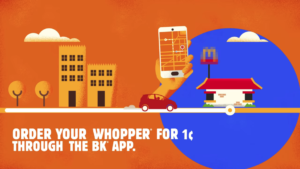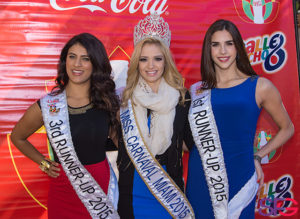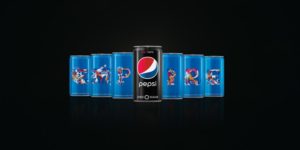Place: The 4 Ps of marketing — selling junk food to communities of color
Thursday, July 25, 2019Drive within a few miles of a fast-food restaurant or grocery store, and a mobile message with a coupon enticing you to stop by could pop up on your phone. Whole Foods Market began using this marketing tactic in 2015, offering specials not only to mobile customers near its stores but also to customers near the stores of its competitors.1 In 2018, McDonald’s employed a similar approach, partnering with the navigation app Waze to send promotions and turn-by-turn directions to travelers within range of a McDonald’s billboard.2 And Burger King has used geolocation technology to send mobile coupons through its app, offering a 1-cent Whopper to any customer approaching McDonald’s.3
 Marketing practices such as these, known as location- or place-based marketing, to increase food sales is not new. But in today’s digital age, food and beverage companies have an ever-expanding set of tools at their disposal, using geofences and other cutting-edge technology to detect nearby shoppers and send personalized ads directly to their mobile devices. Such technology now allows marketers to understand a person’s entire location history — where they go and what they do every minute of the day, including what they buy in stores and online.
Marketing practices such as these, known as location- or place-based marketing, to increase food sales is not new. But in today’s digital age, food and beverage companies have an ever-expanding set of tools at their disposal, using geofences and other cutting-edge technology to detect nearby shoppers and send personalized ads directly to their mobile devices. Such technology now allows marketers to understand a person’s entire location history — where they go and what they do every minute of the day, including what they buy in stores and online.
Besides prompting privacy concerns, these and other place-based practices raise health concerns because many of the foods and beverages being marketed, such as sodas, processed snacks, and fast-food meals, are low in nutrients and high in sugars, salt, and fats. Additionally, many businesses market these items more aggressively to communities of color, which are more likely than predominantly white communities to rely on mobile devices for internet access.4 These junk foods are likely to increase disease risk or interfere with management of chronic conditions — especially in the absence of healthier food and beverage options. Meanwhile, communities of color have been the hardest hit by the current epidemic of diabetes and other nutrition-related diseases.5
Place-based marketing is just one of several ways that companies engage in target marketing, the practice of using tailored approaches to sell products to specific individuals and communities.
What is target marketing?
Target marketing applies the “marketing mix” principles: product, price, place, and promotion. The “4 Ps” model is foundational to today’s digital marketplace and is widely adopted by both marketing practitioners and academics. Some business experts also add other Ps, such as “personalization,” to the mix.

The targeted marketing of unhealthy food and beverages to communities of color is common across all four marketing mix categories, as companies have designed:
- products especially for communities of color;
- prices designed to appeal to specific income groups, such as “value menus” targeting low-income neighborhoods, as communities of color are disproportionately represented within them;
- places that are saturated with unhealthy food products, due to zoning in certain communities that allows concentrations of fast-food restaurants or proliferation of outdoor advertising of unhealthy food and sugary beverages6; and
- promotions that exploit cultural images, symbolism, and language that are recognizable to communities of color to sell products or build brand loyalty.
In this brief, we explain how the marketing mix principle of “place” works and why targeting foods and drinks high in sugars, salt, and fats to communities of color contributes to health inequities.
Where products are sold and consumed
Of the traditional 4 Ps, “place” is the marketing principle that is perhaps the most debated in terms of its relevance in today’s marketplace. That’s because place is becoming more and more virtual — experienced on a laptop, tablet, or smartphone.
In a blog about the 4 Ps, Eduardo Conrado, chief marketing officer for Motorola, wrote that business owners should focus on access instead of place. “Many organizations are moving their business model from ownership to ‘access to,'” he said. “Nowadays, many businesses operate around always-on, high-speed internet access.”7

A screenshot of Burger King’s “Whopper Detour” geolocation promotion.
Cleveland-based marketing firm Purely Branded offers the following explanation of place: “Often you will hear marketers saying that marketing is about putting the right product, at the right price, at the right place, at the right time. It’s critical, then, to evaluate what the ideal locations are to convert potential clients into actual clients. Today, even in situations where the actual transaction doesn’t happen on the web, the initial place potential clients are engaged and converted is online.”8
New advances in digital marketing, including geotargeting that allows marketers to track and target consumers and gather demographic characteristics, are likely to disproportionately impact youth of color, as they are more likely to use smartphones and other mobile technology than white youth.
Just as the 4 Ps work together as part of a comprehensive marketing strategy, each “P” also incorporates an integrated approach. The actual places where products are sold are an essential part of the “place” marketing principle, but so are the places where the products are used and marketed. For example, we now eat and drink in cars, and candy is available in hardware stores, as companies expand where we see, use, and purchase their products.9 Companies routinely use their physical presence to market and sell unhealthy products to communities of color — with dire health consequences.10
For example, a 2014 study published in the American Journal of Preventive Medicine found that Black communities were among groups most disproportionately exposed to child-directed marketing displays at fast-food restaurants.6 Children who eat fast food are likely to consume more total calories, total fat, saturated fat, sodium, sugar, and sugar-sweetened beverages and are less likely to meet dietary recommendations for fruits, vegetables, and dairy.11
Not surprisingly, a 2017 analysis of McDonald’s marketing mix showed that its restaurants generate most of the company sales revenues. Therefore, McDonald’s decided to expand its physical presence with the introduction of kiosks, including temporary ones for seasonal and sports events.12 This strategy has allowed the fast-food giant to distribute and market its products at even more places, including ethnic festivals and other events held in communities of color.
The Panmore Institute’s “place” analysis of McDonald’s focused on its digital strategy, noting: “Customers can place their orders through the Postmates website and mobile app. For example, the company’s mobile apps for iOS and Android OS let customers claim special deals, find restaurant locations, place orders, and pay for such orders involving participating McDonald’s restaurants.” The analysis goes on to explain that the “place” element of McDonald’s marketing mix supports the company’s vision and mission to ensure continuous growth.12, 13
 Coca-Cola banners and logos literally covered the streets of Miami’s Calle Ocho 2015 festival, which celebrates the city’s Latinx community. Coke, which was the official soft drink of the festival, also ran an extensive local TV, radio, and social media campaign.14 (A 2019 study by the UConn Rudd Center for Food Policy and Obesity found that Coca-Cola, one of the Top 5 Spanish-language advertisers among food and beverage companies, more than doubled its Spanish-language TV advertising between 2013 and 2017.15)
Coca-Cola banners and logos literally covered the streets of Miami’s Calle Ocho 2015 festival, which celebrates the city’s Latinx community. Coke, which was the official soft drink of the festival, also ran an extensive local TV, radio, and social media campaign.14 (A 2019 study by the UConn Rudd Center for Food Policy and Obesity found that Coca-Cola, one of the Top 5 Spanish-language advertisers among food and beverage companies, more than doubled its Spanish-language TV advertising between 2013 and 2017.15)
 In 2017, Pepsi teamed up with Fox’s hit TV series “Empire,” a show about an African American music mogul family, to produce “new and immersive content and real-life experiences including extended Empire storylines and music and visual content made accessible … via mobile or online.”16 (Although Coca-Cola and Pepsi have an established and positive relationship with African Americans — both companies hired and promoted African Americans, contracted with Black-owned companies, and supported Black charitable organizations at a time in history when many other industries actively discriminated against African Americans17 — aggressive marketing of their products has wreaked havoc on the health of Black communities.)
In 2017, Pepsi teamed up with Fox’s hit TV series “Empire,” a show about an African American music mogul family, to produce “new and immersive content and real-life experiences including extended Empire storylines and music and visual content made accessible … via mobile or online.”16 (Although Coca-Cola and Pepsi have an established and positive relationship with African Americans — both companies hired and promoted African Americans, contracted with Black-owned companies, and supported Black charitable organizations at a time in history when many other industries actively discriminated against African Americans17 — aggressive marketing of their products has wreaked havoc on the health of Black communities.)
What can we do?
Food and beverage companies must stop aggressively marketing their least healthy products to communities of color. Acknowledging our shared responsibility to keep all communities safe and happy, we encourage continued direct dialogue among industry, community, and health advocates to advance solutions that will help companies improve the nutritional quality of products being marketed and sold to communities of color and families who are low-income.
Lawmakers should enact federal and state privacy policies and digital consumer policies that would restrict food marketing strategies related to geotracking. Cities could create tracking- and targeting-free zones that shield targeted populations from marketing for junk food and other unhealthy products.
Advocates can help by developing or joining public campaigns to hold food and beverage companies — and those selling marketing data to them — accountable.
To learn more about this issue and ways to combat it, read the rest of our target marketing series, and join the target marketing subcommittee of the Food Marketing Workgroup, a coalition of organizations and individuals dedicated to eliminating unhealthy food marketing to young people, especially youth of color. Those interested in joining can email workgroup co-chair and subcommittee lead Berkeley Media Studies Group at info@bmsg.org.
References
1. Girish D. 4 brands that are winning at location-based marketing and how. Beaconstac. https://blog.beaconstac.com/2016/04/4-brands-that-are-winning-at-location-based-marketing-and-how/. Published April 4, 2016. Accessed April 10, 2019.
2. Carouthers P, McPherson E. How McDonald’s embraced a high-tech ad strategy to attract more customers. QSR Magazine. https://www.qsrmagazine.com/sponsored/how-embraced-high-tech-ad-strategy-attract-more-customers. Published March 7, 2019. Accessed April 10, 2019.
3. Tyko K. Last day! Burger King is selling Whoppers for a penny, but you need to head to McDonald’s first. USA Today. https://www.usatoday.com/story/money/2018/12/04/burger-king-penny-whopper-promotion-mcdonalds/2197166002/. Published December 4, 2018. Accessed April 10, 2019.
4. Anderson M. Racial and ethnic differences in how people use mobile technology. Pew Research Center. http://www.pewresearch.org/fact-tank/2015/04/30/racial-and-ethnic-differences-in-how-people-use-mobile-technology/. Published April 30, 2015. Accessed April 10, 2019.
5. Committee on Accelerating Progress in Obesity Prevention; Food and Nutrition Board; Institute of Medicine. Accelerating progress in obesity prevention: Solving the weight of the nation; 2012. doi:10.17226/13275.
6. Ohri-Vachaspati P, Isgor Z, Rimkus L, et al. Child-directed marketing inside and on the exterior of fast food restaurants. Am J Prev Med. 2014; 48(1): 22-30
7. Doyer M. The new 4 P’s in marketing: S.A.V.E. Business Models Inc. https://www.businessmodelsinc.com/the-new-4-ps-in-marketing-s-a-v-e/. Accessed April 10, 2019.
8. Purely Branded. The four Ps of marketing. https://www.purelybranded.com/insights/the-four-ps-of-marketing/. Accessed April 10, 2019.
9. Center for Science in the Public Interest. Temptation at Checkout. https://cspinet.org/temptation. Published August 1, 2015. Accessed May 17, 2019.
10. Cheyne A, Mejia P, Nixon L, Dorfman L. Food and beverage marketing to youth. Current Obesity Reports. 2014; 3(4): 440-450.
11. Ferdman RA. The disturbing ways that fast food chains disproportionately target black kids. The Washington Post. https://www.washingtonpost.com/news/wonk/wp/2014/11/12/the-disturbing-ways-that-fast-food-chains-disproportionately-target-black-kids/. Published November 12, 2014. Accessed May 17, 2019.
12. Meyer P. McDonald’s marketing mix (4Ps) analysis. Panmore Institute. http://panmore.com/mcdonalds-marketing-mix-4ps-analysis. Accessed April 10, 2019.
13. Meyer P. McDonald’s mission statement and vision statement (an analysis). Panmore Institute. http://panmore.com/mcdonalds-vision-statement-mission-statement-analysis. Accessed April 10, 2019.
14. The Coca-Cola Company and The Kiwanis Club of Little Havana sign exclusive Calle Ocho Festival beverage agreement. La Opinión. https://laopinion.com/latinowire/the-coca-cola-company-and-the-kiwanis-club-of-little-havana-sign-exclusive-calle-ocho-festival-beverage-agreement/. Published February 4, 2015. Accessed April 15, 2019.
15. Harris JL, Frazier W. Increasing disparities in unhealthy food advertising targeted to Hispanic and Black youth. UConn Rudd Center for Food Policy and Obesity. http://uconnruddcenter.org/files/Pdfs/TargetedMarketingReport2019.pdf. Published January 2019. Accessed April 10, 2019.
16. PepsiCo. Pepsi and Fox make music again for the spring return of “Empire” season three. Cision PR Newswire. https://www.prnewswire.com/news-releases/pepsi-and-fox-make-music-again-for-the-spring-return-of-empire-season-three-300424881.html. Published March 16, 2017. Accessed April 15, 2019.
17. Hale GE. Opinion: When Jim Crow drank coke. The New York Times. https://www.nytimes.com/2013/01/29/opinion/when-jim-crow-drank-coke.html. Published October 19, 2018. Accessed May 17, 2019.
Acknowledgments
This brief was written by Fernando Quintero, with editing support from Lori Dorfman, Heather Gehlert, and Daphne Marvel. Thanks to Sarah Han and Heather Gehlert for design contributions.
This brief was funded by a grant from the Robert Wood Johnson Foundation.
© 2019 Berkeley Media Studies Group, a program of the Public Health Institute




